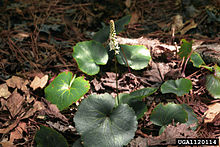Galax
| Galax | |
|---|---|

| |
| Scientific classification | |
| Kingdom: | Plantae |
| Clade: | Tracheophytes |
| Clade: | Angiosperms |
| Clade: | Eudicots |
| Clade: | Asterids |
| Order: | Ericales |
| Family: | Diapensiaceae |
| Genus: | Galax Sims |
| Species: | G. urceolata
|
| Binomial name | |
| Galax urceolata | |
Galax, the wandplant, wandflower, or beetleweed, is a genus in the flowering plant family Diapensiaceae, containing a single species, Galax urceolata (syn. G. rotundifolia, G. aphylla). It is native to the southeastern United States from Massachusetts and New York south to northern Alabama, growing mainly in the Appalachian Mountains at altitudes of up to 1,500 m, where it grows in shaded places in forests. Galax urceolata may be a diploid, triploid, or autotetraploid (autopolyploid).[1]
Description[]
It is an evergreen herbaceous perennial plant growing to 30–45 cm (rarely 75 cm) tall, with a rosette of leathery leaves which grow only at the base of the plant, and turn brown during winter. The leaves are a rounded cardioid (heart) shape, 2.5–7.5 cm diameter, rarely up to 15 cm, with a serrated margin with rounded "teeth". The flowers are produced in late spring to early summer, white in color and on a single spike-like raceme 15–25 cm long on top of a 20–50 cm tall stem. Each individual flower has five petals, and is up to 4 mm or 0.15 inches in diameter. The fruit is a small capsule containing numerous seeds.
Uses[]
The leaves are often harvested for the floristry industry; concern has been expressed over excessive exploitation, and collection is now restricted in many areas. It has also been used in herbalism to treat cuts and kidney ailments. It is occasionally grown as an ornamental plant in gardens.
The independent city of Galax, Virginia, is named after this plant.
References[]
- ^ Stebbins, G. Ledyard (1950-12-31). Variation and Evolution in Plants. New York Chichester, West Sussex: Columbia University Press. doi:10.7312/steb94536. ISBN 978-0-231-89916-1.
External links[]
- Plants for a Future: Galax urceolata
- Galax (Galax urceolata): an annotated bibliography USDA Southern Research Station, 2005.
- photo of Galax urceolata at flickr.com
- Diapensiaceae
- Monotypic Ericales genera
- Flora of the Southeastern United States
- Endemic flora of the United States
- Garden plants of North America
- Medicinal plants of North America
- Flora of the Northeastern United States
- Ericales stubs